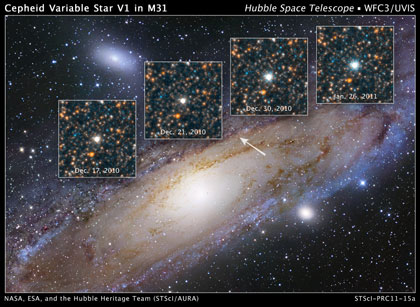
Standard candles
Image: A cepheid variable star in action, showing the variation in its luminosity over time.
To measure the expansion of the Universe, cosmologists utilize standardized references. One such standard reference is standard candles. These are objects where the intrinsic luminosity of the object is known – that is, how much light/radiation is emitted by the object at source. By comparing this amount with how much light from the objects reaches us, the apparent luminosity, we get a measure of how far away the object is from us. Combined with an estimate of the relative size of the Universe at the time the object emitted the light, we can then map the expansion history of the Universe.
Two key aspects of establishing a standard candle is the class definition (how to define and select the objects) and calibration (how to bring the objects to a common reference point). The class definition must be restricted enough to provide something standardizable, and calibration must be accurate enough to provide good distance measurements.
The most important standard candles today are Type Ia supernovae, whose pioneering use led to the discovery of dark energy, based on the Phillips relationship discovered by Mark M. Phillips in 1993. The first discovered standard candles are cepheid variables, stars whose period of variation in luminosity can be translated into a distance. These were first identified by Henrietta Swan Leavitt in 1908, and more conclusively established in 1912. Thanks to the cepheid standard candles, Edwin Hubble could later measure the distance to nebulae and show that they were located outside the Milky Way. Thereby, “the Great Debate” on whether the Milky Way constitutes all of the Universe or whether there are other distant galaxies was settled.
Links
The Universe Review: Standard candles in astronomy >


